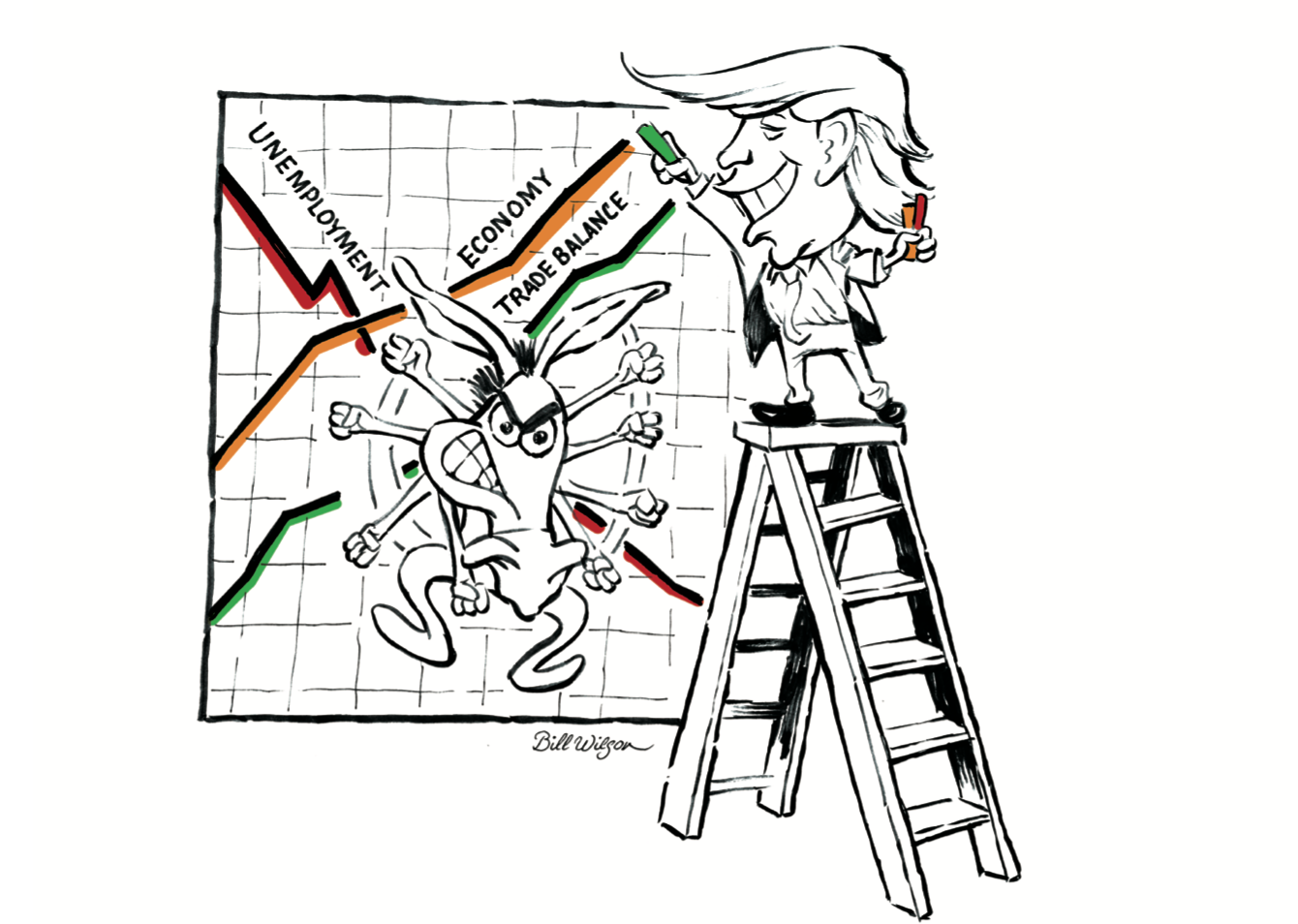After six months of President Donald J. Trump’s audacious initiatives, the economic data tells the story: The United States should avert any semblance of a recession this year, a downturn many liberals not only predicted but hoped would eventuate.
Despite global uncertainties, a new tariff policy, and global trade tensions, the U.S. economy showed an impressive comeback in the second quarter of 2025. An advance estimate from the Bureau of Economic Analysis shows that the U.S. economy grew at a rate of 3 percent, following an unfortunate but understandable performance of less than 1 percent in the first three months of the year.
The handwringing, the posturing, and the hyped rhetoric of an “impending” recession should now subside. If one surveys this year’s economic indices, nearly all the indications of a strong economy are present. The Federal Reserve reported that civilian unemployment in July stood at a low 4.2 percent.
Although the downward revisions concerning job growth were a surprise, they shouldn’t have been. Given the media’s relentless claims of impending doom regarding Trump’s tariff proposals, both Main Street and Wall Street had trepidations. Yet, over the twelve months leading up to the end of July, average hourly earnings for U.S. workers have increased by 3.9 percent.
The central measure of inflation from the Consumer Price Index held steady at 2.7 percent over the twelve months ending in July, far below the forty-year high recorded under the auspices of President Joe Biden. As a sequitur to subdued inflation, consumer spending reached an all-time high in the second quarter, growing at an estimated annual rate of 3.7 percent.
Moreover, if economic parameters remain unchallenged, retail spending should continue to grow in 2026. It is therefore not surprising to see that consumer confidence climbed from 60.7 in June to 61.8 in July. The University of Michigan’s confidence survey reached its highest point in five months in July as inflation expectations began to recede.
Even the bellwether average price of eggs dropped precipitously in August to $2.15 per dozen, down from its high of $8.17 in March. August also witnessed stock market indices rallying toward record highs after a better-than-expected inflation report. They recovered from the sell-off this spring that was driven by hyped uncertainty over Trump’s tariffs. The S&P 500 and Nasdaq both reached record highs.
### The Tariffs’ Least-Discussed Advantage
By executive order, the Trump administration set a baseline 10 percent levy on a broad array of goods from nearly all U.S. trading partners. Some categories of imports as well as goods from certain nations (e.g., Brazil and India) face substantially higher rates (up to 50 percent).
If rates are implemented as announced, the average U.S. tariff rate will rise to 15.2 percent, according to Bloomberg Economics. That’s significantly higher than the 2.3 percent levy that was in place before Trump took office.
The president’s new trade deal with the European Union could itself be a predicate for continued economic growth, particularly in energy and construction. The agreement secures the purchase of $750 billion in energy and investments of $600 billion in the U.S. economy, plus additional sales of military hardware.
Given that America and the European Union constitute the two largest economies globally, these are modest though not insignificant sums.
Trump’s tariffs already constitute a significant source of revenue for the federal government. The Committee for a Responsible Federal Budget estimated in August that the revenue could be equivalent to creating a new payroll tax or cutting the defense budget by nearly 20 percent.
The committee estimates that Trump’s assessed tariffs produced roughly $25 billion in collections in July, likely a fraction of what subsequent months will yield. The budget watchdog estimates that tariff revenue will generate an estimated $1.3 trillion through the end of Trump’s current term and $2.8 trillion through 2034. That represents a $600 billion increase from what was estimated under the old tariff regime.
### National Debt Reduction
A word of caution. The federal government plans to spend a total of $7 trillion in 2025 while bringing in $5.16 trillion in revenue. That leaves a deficit of approximately $1.8 trillion, meaning the government is spending significantly more (26 percent) than it’s earning.
The last surplus for the federal government was in 2001. Since then, the federal budget has remained in deficit, with the highest deficit of $3.13 trillion recorded in 2020, the year the COVID pandemic struck.
One of the most disconcerting components of this year’s federal budget is how much is being spent just on interest payments. The Congressional Budget Office indicates that Congress allocated a total of $952 billion, or 14 percent of total spending, toward paying the interest on U.S. Treasury obligations.
As the debt grows and interest rates remain high, this category is becoming one of the largest in the budget.
In theory, pouring trillions of dollars from tariffs into the U.S. Treasury should, Congressional Budget Office figures suggest, slow the growth of federal debt.
“The recent tariff increases are likely to meaningfully reduce deficits if allowed to remain in effect,” the Committee for a Responsible Federal Budget wrote in August. But the effect of tariff revenue on the debt remains limited when compared to the sheer scale of $7 trillion in U.S. government spending.
However, that is not the primary purpose of the tariffs.
### What Really Matters
Tariffs in the age of Trump are a lever used to increase foreign investment. From microprocessor facilities in Arizona to EV battery plants in North Carolina, foreign companies are pledging billions to get access to the world’s largest consumer market.
The tariffs are more about real financial commitments than a new source of revenue. Skeptics assert that foreign direct investment is typically just acquisitions of existing capital, not new plants or jobs. That’s true, which is why Trump’s approach insists on building (not buying) something. It’s about factories, not finances.
Trump’s economic policy should be judged by its results: steel and concrete infrastructure, goods produced, and Americans on payrolls. The typical investment model says: Take in capital and let financial markets sort out the details. Trump’s new model says: If foreign capital wants in, it has to build something real in America.
From a purely financial vantage point, if accompanied by reduced government spending, the tariffs could help close the deficit, but bringing trade imbalances into a more equitable alignment is the real measure of success. And the data shows it’s working.
### Trump’s Critics
Despite the abundance of robust economic data, Nobel Prize-winning economist Paul Krugman wrote in Rolling Stone that Trump and “MAGAnomics” were “destroying the economy and waging war on the middle class and the poor.”
Vox was also busy in April publishing under a headline that read “The real reason Trump is destroying the economy.” Their take on Trump isn’t just that he is wrecking the economy, but that America’s supposedly declining democracy enabled this in the first place. Apparently, it is your fault.
Bitterness from losing an election and then resenting your opponent’s success can produce the worst kinds of behavior, especially when millions of Americans around you seem to see what you refuse to.
A robust economy under any president should be great news for all Americans regardless of partisan preferences. When the economy under Biden slumped, it was not a reason to rejoice. A poorly functioning economy under any president threatens the trust of and confidence in the institutions of a functioning republic.
Well into Biden’s term in office, the inflation rate rose to 9 percent, the highest rate in forty years. Americans struggled with its effects: escalating costs of food, housing, and transportation.
It is no surprise that an October 2024 Gallup poll revealed that more than 50 percent of the American electorate said that the economy was the key issue for them in the election.
Donald Trump garnered 77.3 million of that voting electorate and returned to the White House with a mandate to fix these stubborn economic problems.
While the verdict is not final, the most recent economic data shows that Trump is delivering on this mandate, even if some people are unhappy about it.
https://spectator.org/trumps-economic-success-leaves-liberals-red-faced/?utm_source=rss&utm_medium=rss&utm_campaign=trumps-economic-success-leaves-liberals-red-faced



